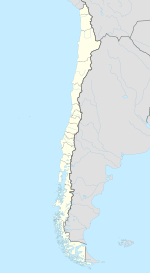Copiapó
| Copiapó | |||||||
|---|---|---|---|---|---|---|---|
| City and Commune | |||||||
|
|||||||
|
|||||||
| Coordinates: 27°21′59″S 70°19′59″W / 27.36639°S 70.33306°WCoordinates: 27°21′59″S 70°19′59″W / 27.36639°S 70.33306°W | |||||||
| Country |
|
||||||
| Region |
|
||||||
| Province | Copiapó | ||||||
| Founded | December 8, 1744 | ||||||
| Founded by | José Antonio Manso de Velasco | ||||||
| Government | |||||||
| • Type | Municipality | ||||||
| • Alcalde | Marcos López (IND) | ||||||
| Area | |||||||
| • Total | 16,681.3 km2 (6,440.7 sq mi) | ||||||
| Elevation | 390 m (1,280 ft) | ||||||
| Population (2012) | |||||||
| • Total | 158,438 | ||||||
| • Density | 9.5/km2 (25/sq mi) | ||||||
| Time zone | CLT (UTC−4) | ||||||
| • Summer (DST) | CLST (UTC−3) | ||||||
| Postal code | 1530000 | ||||||
| Area code(s) | (+56) 52 | ||||||
| Climate | BWk | ||||||
| Website |
www |
||||||
Copiapó (Spanish pronunciation: [kopjaˈpo]) is a city in northern Chile, located about 65 kilometers east of the coastal town of Caldera. Founded on December 8, 1744, it is the capital of Copiapó Province and Atacama Region.
Copiapó lies about 800 km north of Santiago by the Copiapó River, in the valley of the same name. In recent years, the river has dried up. The town is surrounded by the Atacama Desert and receives 12 mm (½ in) of rain per year. The population of Copiapó was 9,128 in 1903, 11,617 in 1907 and, as of 2012, there are 158,438 inhabitants.
Copiapó is in a rich silver and copper mining district. It possesses a bronze statue of Juan Godoy, discoverer of the Chañarcillo silver mines in the 19th century. The Copiapó-Caldera railway line, built in 1850, was the first one in South America. The first section between Caldera and Monte Amargo was inaugurated on July 4 of 1850 in honour of the nationality of William Wheelwright, the American business man responsible for the project. The original wooden railway station is now a National Monument.
The town was christened San Francisco de la Selva de Copiapó or Saint Francis of the Jungle of Copiapó, due to its lush vegetation. Prior to Spanish occupation, the area was inhabited by the Diaguita people under the rule of the Inca Empire. The earliest archaeological remains of human activity in the Copiapó Valley have been dated at ten thousand years BP.
...
Wikipedia









